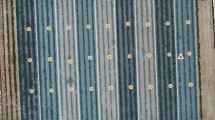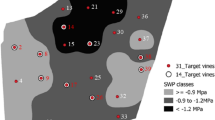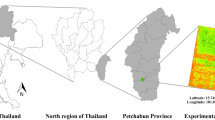Abstract
The goal of this study was to assess the water status variability of a commercial rain-fed Tempranillo vineyard (Vitis vinifera L.) by thermal and multispectral imagery using an unmanned aerial vehicle (UAV). The relationships between aerial temperatures or indices derived from the imagery and leaf stomatal conductance (g s) and stem water potential (Ψstem) were determined. Aerial temperature was significantly correlated with g s (R 2 = 0.68, p < 0.01) and Ψstem (R 2 = 0.50, p < 0.05). Furthermore, the thermal indices derived from aerial imagery were also strongly correlated with Ψstem and g s. Moreover, different spectral indices were related to vineyard water status, although NDVI (normalized difference vegetation index) and TCARI/OSAVI (ratio between transformed chlorophyll absorption in reflectance and optimized soil-adjusted vegetation index) showed the highest coefficient of determination with Ψstem (R 2 = 0.68, p < 0.05) and g s (R 2 = 0.84, p < 0.05), respectively. While the relationship with thermal imagery and water status parameters could be considered as a short-term response, NDVI and TCARI/OSAVI indices were probably reflecting the result of cumulative water deficits, hence a long-term response. In conclusion, thermal and multispectral imagery using an UAV allowed assessing and mapping spatial variability of water status within the vineyard.





Similar content being viewed by others
References
Acevedo-Opazo C, Tysseire B, Taylor J, Ojeda H, Guillaume S (2010) Spatial prediction model of the vine (Vitis vinifera L.) water status using high resolution ancillary information. Precis Agr 11:358–378
Acevedo-Opazo C, Tisseyre B, Ojeda H, Ortega-Farias S, Guillaume S (2008a) Is it possible to assess the spatial variability of vine water status? J Int Sci Vigne Vin 42:203–219
Acevedo-Opazo C, Tisseyre B, Guillaume S, Ojeda H (2008b) The potential of high resolution information to define within-vineyard zones related to vine water status. Precis Agr 9:285–302
Alchanatis V, Cohen Y, Cohen S, Moller M, Sprinstin M, Meron M, Tsipris J, Saranga Y, Sela E (2010) Evaluation of different approaches for estimating and mapping crop water status in cotton with thermal imaging. Precis Agric 11:27–41
Allen RG, Pereira LS, Raes D, Smith M (1999) Crop evapotranspiration. FAO irrigation and drainage paper 56. Rome: FAO
Arnó J, Martínez Casanovas J, Ribes-Dasi M, Rosell JR (2009) Review. Precision viticulture. Research topics, challenges and opportunities in site-specific vineyard management. Spanish J Agric Res 7:779–790
Ben-Gal A, Agam N, Alchanatis V, Cohen Y, Yermiyahu U, Zipori I, Presnov E, Sprintsin M, Dag A (2009) Evaluating water stress in irrigated olives: correlation of soil water status, tree water status, and thermal imagery. Irrig Sci 27:367–376
Berni JAJ, Zarco-Tejada PJ, Suarez L, Fereres E (2009) Thermal and narrow-band multispectral remote sensing for vegetation monitoring from an unmanned aerial vehicle. IEEE Trans Geosci Rem Sens 47:722–738
Bramley RGV (2010) Precision viticulture: Managing vineyard variability for improved quality outcomes. Chapter 12. In: Reynolds AG (ed) Understanding and managing wine quality and safety. Woodhead Publishing, Cambridge, pp 445–480
Broge NH, Leblanc E (2001) Comparing prediction power and stability of broadband and hyperspectral vegetation indices for estimation of green leaf area index and canopy chlorophyll density. Rem Sens Environ 76:156–172
Chapman DM, Roby G, Ebeler SE, Guinard JX, Matthews MA (2005) Sensory attributes of Cabernet Sauvignon wines made from vines with different water status. Aust J Grape Wine Res 11:339–347
Chaves MM, Santos TP, Souza CR, Ortuño MF, Rodrigues ML, Lopes CM, Maroco JP, Pereira JS (2007) Deficit irrigation in grapevine improves water-use efficiency while controlling vigour and production quality. Ann Appl Biol 150:237–252
Chen J (1996) Evaluation of vegetation indices and modified simple ratio for boreal applications. Can J Remote Sens 22:229–242
Cifre J, Bota J, Escalona JM, Medrano H, Flexas J (2005) Physiological tools for irrigation scheduling in grapevine (Vitis vinifera L.) An open gate to improve water-use efficiency? Agr Ecosyst Environ 106:159–170
Cohen Y, Alchanatis V, Meron M, Saranga S, Tsipris J (2005) Estimation of leaf water potential by thermal imagery and spatial analysis. J Exp Bot 56:1843–1852
Cohen Y, Alchanatis V, Prigojin A, Levi A, Soroker V, Cohen Y (2011) Use of aerial thermal imaging to estimate water status on palm trees. Precis Agric. doi:10.1007/s11119-011-9232-7
Costa JM, Grant OM, Chaves MM (2010) Use of Thermal Imaging in Viticulture: Current Application and Future Prospects. In: Delrot S, Medrano H, Or E, Bavaresco L, Grando S (eds) Methodologies and results in grapevine research. Springer, New York, pp 135–150
Daughtry CST, Walthall CL, Kim MS, Brown de Colstoun E, McMurtrey JE III (2000) Estimating corn leaf chlorophyll concentration from leaf and canopy reflectance. Rem Sens Environ 74:229–239
De Bei R, Cozzolino D, Sullivan W, Cynkar W, Fuentes S, Dambergs R, Pech J, Tyerman S (2011) Non-destructive measurement of grapevine water potential using near infrared spectroscopy. Aust J Grape Wine Res 17:62–71
Escalona JM, Flexas J, Medrano H (2002) Drought effects on water flow, photosynthesis and growth of potted grapevines. Vitis 41:57–62
Flexas J, Escalona JM, Evain S, Gulias J, Moya I, Osmond CB, Medrano H (2002) Steady-state chlorophyll fluorescence (Fs) measurements as a tool to follow variations of net CO2 assimilation and stomatal conductance during water-stress in C3 plants. Physiol Plant 114:231–240
Fuchs M (1990) Infrared measurement of canopy temperature and detection of plant water stress. Theor Appl Climatol 42:253–261
Fuentes DA, Gamon JA, Qiu HL, Sims DA, Roberts DA (2001) Mapping Canadian boreal forest vegetation using pigment and water absorption features derived from the AVIRIS sensor. J Geophys Res 106:33565–33577
Gamon JA, Surfus JS (1999) Assessing leaf pigment content and activity with a reflectometer. New Phytol 143:105–117
Girona J, Mata AM, Del Campo J, Arbone A, Bartra E, Marsal J (2006) The use of midday leaf water potential for scheduling deficit irrigation in vineyards. Irrig Sci 24:115–117
Gitelson AA, Merzlyak MN (1998) Remote sensing of chlorophyll concentration in higher plant leaves. Adv Space Res 22:689–692
Grant OM, Tronina L, Jones HG, Chaves MM (2007) Exploring thermal imaging variables for the detection of stress responses in grapevine under different irrigation regimes. J Exp Bot 58:815–825
Haboudane D, Miller JR, Tremblay N, Zarco-Tejada PJ, Dextraze L (2002) Integrated narrow-band vegetation indices for prediction of crop chlorophyll content for application to precision agriculture. Rem Sens Environ 84:416–426
Haboudane D, Miller JR, Pattey E, Zarco-Tejada PJ, Strachan IB (2004) Hyperspectral vegetation indices and novel algorithms for predicting green LAI of crop canopies: modeling and validation in the context of precision agriculture. Rem Sens Environ 90:337–352
Hall A, Lamb DW, Holzapfel B, Louis J (2002) Optical remote sensing applications in viticulture: a review. Aust J Grape Wine Res 8:36–47
Hofierka J (1997) Direct solar radiation modelling within an open GIS environment. Conference, Vienna, Austry
Hofierka J, Súri M (2002) The solar radiation model for open source GIS:implementation and applications. Open source GIS-GRASS users conference. Trento, Italy
Hofierka J, Mitasova H, Neteler M (2009) Chapter 17: geomorphometry in GRASS GIS. Dev Soil Sci 33:387–410
Holben BN, Tanré D, Smirnov A, Eck TF, Slutsker I, Abuhassan N, Newcomb WW, Schafer JS, Chatenet B, Lavenu F, Kaufman YJ, Vande-Castle J, Setzer A, Markham B, Clark D, Frouin R, Halthore R, Karneli A, O’Neill NT, Pietras C, Pinker RT, Voss K, Zibordi G (2001) An emerging ground-based aerosol climatology. Aerosol optical depth from AERONET. J Geophys Res 106:12067–12097
Idso SB, Jackson RD, Pinter PJ, Reginato RJ, Hatfield JL (1981) Normalizing the stress degree- day parameter for environmental variability. Agr Forest Meteorol 24:45–55
Intrigliolo DS, Castel JR (2007) Evaluation of grapevine water status from trunk diameter variations. Irrig Sci 26:49–59
Jones HG (1992) Plants and microclimate. Cambridge University Press, Cambridge
Jones HG (1999) Use of infrared thermometry for estimation of stomatal conductance as a possible aid to irrigation scheduling. Agr Forest Meteorol 95:139–149
Jones HG (2004a) Irrigation scheduling: advantages and pitfalls of plant based methods. J Exp Bot 55:2427–2436
Jones HG (2004b) Application of thermal imaging and infrared sensing in plant physiology and ecophysiology. Adv Bot Res 41:107–163
Jones HG, Stoll M, Santos T, De Sousa C, Chaves MM, Grant OM (2002) Use of infrared thermography for monitoring stomatal closure in the field: application to grapevine. J Exp Bot 53:2249–2260
Jones HG, Serraj R, Loveys BR, Xiong L, Wheaton A, Price AH (2009) Thermal infrared imaging of crop canopies for the remote diagnosis and quantification of plant responses to water stress in the field. Funct Plant Biol 36:978–989
Jordan CF (1969) Derivation of leaf area index from quality of light on the forest floor. Ecology 50:663–666
Karantzalos K, Argialas D (2006) Improving edge detection and watershed segmentation with anisotropic diffusion and morphological levelings. Int J Rem Sens 27:5427–5434
Kasten F (1996) The linke turbidity factor based on improved values of the integral Rayleigh optical thickness. Sol Energy 56:239–244
Kazmierski M, Glemas P, Rousseau J, Tisseyre B (2011) Temporal stability of within-field patterns of NDVI in non irrigated Mediterranean vineyards. J Int Sci Vigne Vin 45:61–73
Kim MS, Daughtry CST, Chappelle EW, McMurtrey JE (1994) The use of high spectral resolution bands for estimating absorbed photosynthetically active radiation (APAR) In Proceedings for ISPRS’94 299–306.Val d’Isere, France
Leinonen I, Grant OM, Tagliavia CPP, Chaves MM, Jones HG (2006) Estimating stomatal conductance with thermal imagery. Plant Cell Environ 29:1508–1518
Meggio F, Zarco-Tejada PJ, Miller JR, Martín P, González MR, Berjón A (2008) Row orientation and viewing geometry effects on row-structured vine crops for chlorophyll content estimation. Can J Rem Sens 34(3):220–234
Meggio F, Zarco-Tejada PJ, Núñez LC, Sepulcre-Cantó G, González MR, Martín P (2010) Grape quality assessment in vineyards affected by iron deficiency chlorosis using narrow-band physiological remote sensing indices. Rem Sens Environ 114:1968–1986
Metz M, Mitasova H, Harmon RS (2011) Accurate stream extraction from large, radar-based elevation models. Hydrol Earth Syst Sci 15:667–678. doi:10.5194/hess-15-667-2011
Mitasova H, Mitas L, Harmon RS (2005) Simultaneous spline approximation and topographic analysis for lidar elevation data in open-source GIS. Geosci Rem Sens Lett IEEE 2:375–379
Möller M, Alchanatis V, Cohen Y, Meron M, Tsipris J, Naor A, Ostrovsky V, Sprintsin M, Cohen S (2007) Use of thermal and visible imagery for estimating crop water status of irrigated grapevine. J Exp Bot 58:827–838
Neteler M, Mitasova H (2007) Open GIS: a grass GIS approach. Springer, New York
Ochagavía H, Grant OM, Baluja J, Diago MP, Tardáguila J (2011) Exploring zenithal and lateral thermography for the assessment of vineyard water status. Proceedings of 17th International Symposium of GiESCO. Asti–Alba (Italia)
Ojeda H, Andary C, Kraeva E, Carbonneau A, Deloire A (2002) Influence of pre and postveraison water deficit on synthesis and concentration of skin phenolic compounds during berry growth of Vitis vinifera cv Shiraz. Am J Enol Vitic 53:261–267
Otsu N (1979) Threshold selection method from gray-level histograms. IEEE Trans Syst Man Cybern 9:62–66
Pieri P, Gaudillére JP (2003) Sensitivity to training system parameters and soil surface albedo of radiation intercepter by vine rows. Vitis 42:77–82
Qi J, Chehbouni A, Huete AR, Kerr Y (1994) A modified soil adjusted vegetation index (MSAVI). Rem Sens Environ 48:119–126
Reujean J, Breon F (1995) Estimating PAR absorbed by vegetation from bidirectional reflectance measurements. Rem Sens Environ 51:375–380
Rigollier C, Bauer O, Wald L (2000) On the clear sky model of the ESRA with respect to the heliosat method. Sol Energy 68:33–48
Rodríguez-Pérez JR, Riaño D, Carlisle E, Ustin S, Smart DR (2007) Evaluation of hyperspectral reflectance indexes to detect grapevine water status in vineyards. Am J Enol Vitic 58:302–317
Rondeaux G, Steven M, Baret F (1996) Optimization of soil-adjusted vegetation indices. Rem Sens Environ 55:95–107
Rouse J, Haas RH, Schell JA, Deering DW, Harlan JC (1974) Monitoring the vernal advancement and retrogradation (Greenwave effect) of natural vegetation. RS Center, A Texas, GSF Center—1974—Texas A & M University, Remote Sensing Center
Safren O, Alchanatis V, Ostrovsky V, Levi O (2007) Detection of green apples in hyperspectralimages of apple-tree foliage using machine vision. Trans ASABE 50:2303–2313
Sepulcre-Cantó G, Diago MP, Balda P, Martínez de Toda F, Morales F, Tardaguila J (2009) Monitoring vineyard spatial variability of vegetative growth and physiological status using an unmanned aerial vehicle (UAV). In: Proceedings of GIESCO symposium. Davis, USA
Tardaguila J, Baluja J, Arpon L, Balda P, Oliveira M (2011) Variations of soil properties affect the vegetative growth and yield components of “Tempranillo” grapevines. Precis Agr 12:762–773
Zarco-Tejada PJ, Berjón A, López-Lozano R, Miller JR, Martín P, Cachorro V, González MR, de Frutos A (2005a) Assessing vineyard condition with hyperspectral indices: leaf and canopy reflectance simulation in a row-structured discontinuous canopy. Rem Sens Environ 99:271–287
Zarco-Tejada PJ, Ustin SL, Whiting ML (2005b) Temporal and spatial relationships between within-field yield variability in cotton and high-spatial hyperspectral remote sensing imagery. Agron J 97:641–653
Zarco-Tejada PJ, Berni JAJ, Suárez L, Fereres E (2008) A new era in remote sensing of crops with unmanned robots. SPIE Newsroom. doi:10.1117/2.1200812.1438
Acknowledgments
This work was supported by the Agencia de Desarrollo Económico de La Rioja (ADER) with the Project TELEVITIS 2008-I-ID-00123. The authors want to thank Domecq Bodegas allowing the execution of this study in their commercial vineyard. Gratefulness also to Dr. Pablo Zarco-Tejada and Dr. Guadalupe Sepulcre-Cantó for their collaboration and advice on this study. Also, the authors wish to acknowledge the Quantalab (IAS, CSIC) participation in the UAV flights. Also, the authors want to thank Markus Metz for the support provided with r.watershed algorithm and the PGIS team (FEM, IASMA), particularly Markus Neteler, for the support with GRASS GIS. Fermín Morales thanks Gobierno de Aragón (A03 research group) for financial support.
Author information
Authors and Affiliations
Corresponding author
Additional information
Communicated by S. Ortega-Farias.
Rights and permissions
About this article
Cite this article
Baluja, J., Diago, M.P., Balda, P. et al. Assessment of vineyard water status variability by thermal and multispectral imagery using an unmanned aerial vehicle (UAV). Irrig Sci 30, 511–522 (2012). https://doi.org/10.1007/s00271-012-0382-9
Received:
Accepted:
Published:
Issue Date:
DOI: https://doi.org/10.1007/s00271-012-0382-9




